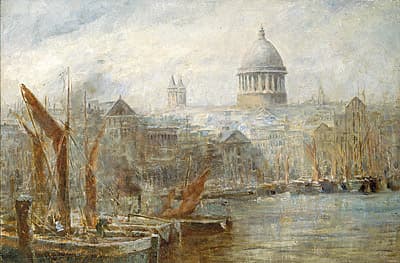Frederick
MCCUBBIN
Australia
1855
–
1917
The Pool of London (Barges, Pool of London)
1907
oil on canvas
signed and dated 'F. McCubbin/ 1907' lower left
49.0 (h)
x 75.0 (w)
cm
Private collection
McCubbin had made sketches of London and the Thames during his stay there in 1907 (cat 6), but it is not known whether he painted this work (on a French canvas) in London or after his return to Melbourne on 18 November. In the distance, surrounded by haze, is the looming dome of St Pauls cathedral. To the left are smoking chimneys. In the foreground there are barges, including a bargeman bent over at work, suggesting the busy commercial activity in this part of the Thames. McCubbin used a low viewpoint to paint the scene, allowing him to make the most of the water’s reflections.
The Pool of London was originally the stretch of the Thames which formed the south side of the City of London. The Upper Pool consisted of the section between London Bridge and Tower Bridge, looking across to the Tower of London. McCubbin’s viewpoint, however, with St Pauls in the distance, is likely to have been slightly closer to Westminster, on Bankside, somewhere between Blackfriars Bridge and London Bridge.
In London, McCubbin was particularly impressed by the work of Turner. He wrote to his wife on 19 July 1907: ‘I went yesterday with Fullwood and G. Coates and Tom Roberts for a ramble … to the Tate Gallery—a beautiful freestone building facing the river—[we passed] through a portico into the Gallery where the lately found Turners are exhibited—these are not like the greater number of pictures in the National Gallery—they represent his different periods, but are mostly in his latest style, when he had realised the quality of light (Mackenzie 1990, p 259).
In The Pool of London McCubbin paid homage to Turner, and to Turner’s images of the water and buildings in Venice. Like Turner, he painted this work with opalescent colour, glorying in capturing the diffused London light. While in London he had observed that the light was not as strong as in Australia: ‘we have more colour in our landscape than they have in England and more light, the trees so often look black’ (Mackenzie, p 256). Here, McCubbin captured the muted blues, reds, purples, pinks, and ochres of smoggy industrial London, so different from the green pastures of Australia.
In McCubbin’s choice of subject, as Patrick McCaughey has observed, there was also a link to Turner, and Turner’s childhood as described by John Ruskin:
‘That mysterious forest below London Bridge’ … how he must have tormented the watermen, beseeching them to let him crouch anywhere in the bows, quiet as a log, so only that he might get floated down there among the ships and round and round the ships, and with the ships, and by the ships, and under the ships, staring and clambering—these the only quite beautiful things he can see in all the world, except the sky (McCaughey 1979, p 64).
